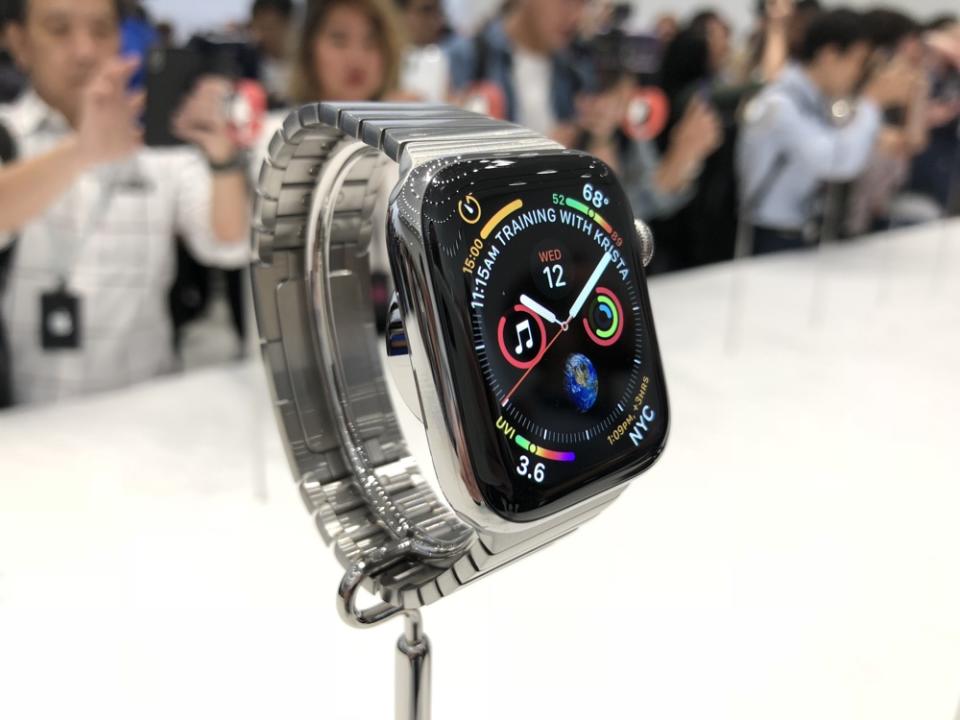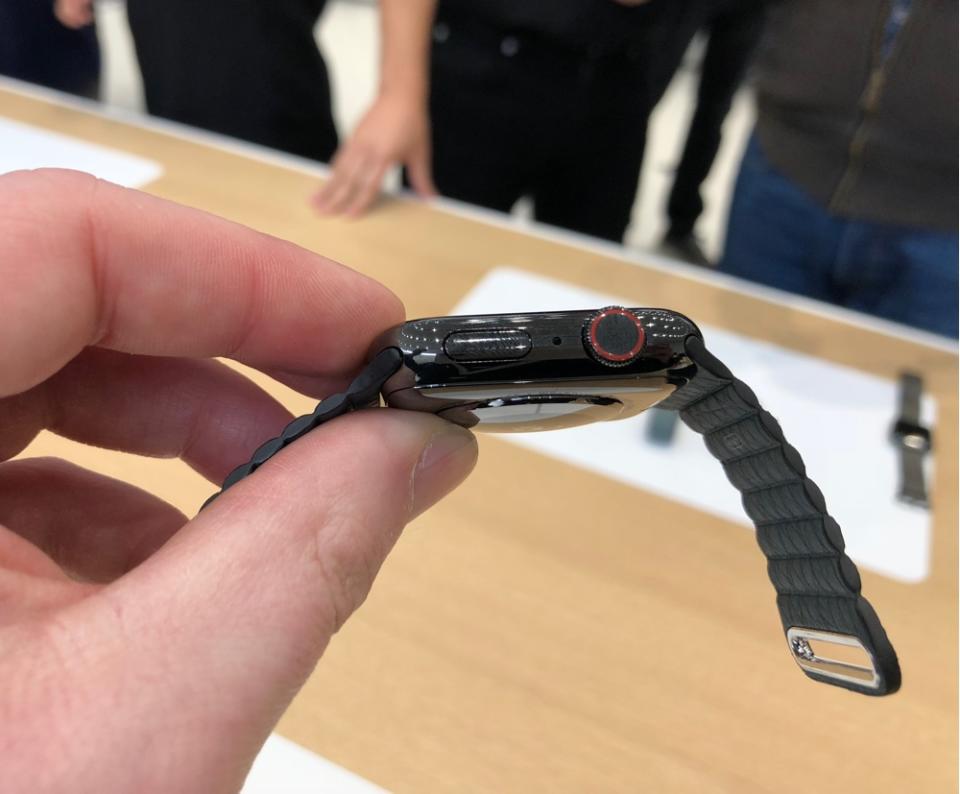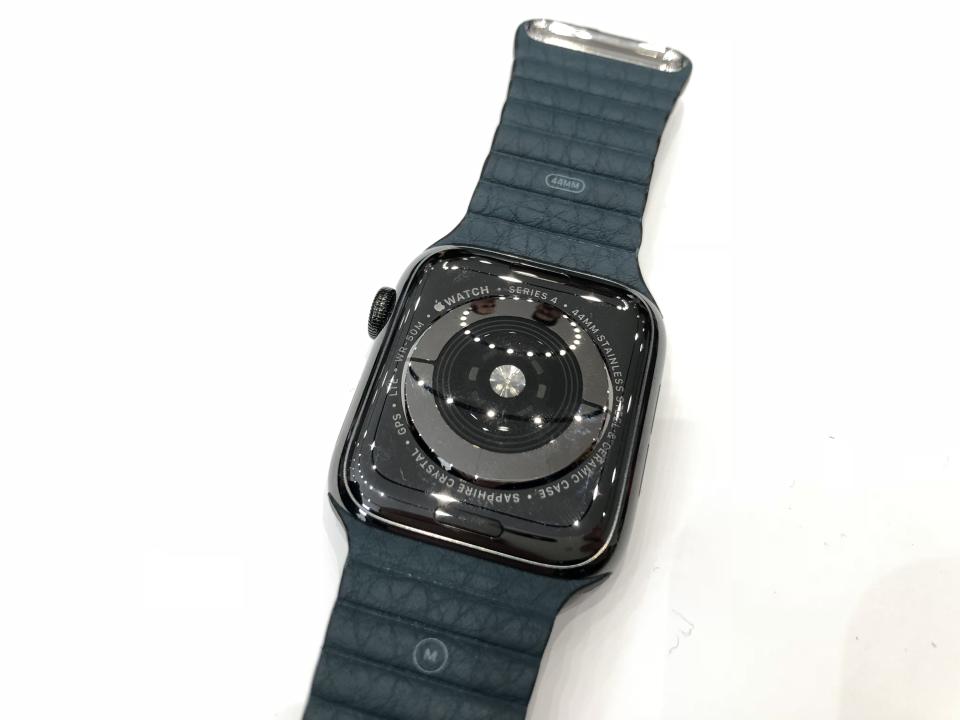Apple Watch Series 4 hands-on: Big screens, big improvements
Apple (AAPL) CEO Tim Cook took the wraps off of the $1 trillion-company’s newest smartwatch on Wednesday. The Apple Watch Series 4, which goes on sale Sept. 21 starting at $399, is the first major upgrade to the device since it debuted in 2015.
The Watch now comes with larger displays, an electrocardiogram and a thinner body than the Series 3. But the one thing Apple didn’t improve was the Watch’s battery life. Still, for the average consumer, this is absolutely the Apple Watch to get.
Bigger screen, thinner body
For the Series 4, Apple has completely changed its case sizes. Previous Apple Watches were available in 38mm and 42mm sizes. I wear the 42mm Series 3 and it sits perfectly on my wrist. Now, however, Apple is offering the Apple Watch in 40mm ($399) and 44mm ($429). The Series 4 also has an edge-to-edge display, meaning there’s far more screen real estate.
Despite the increased sizes, the Series 4 still fits nicely. It didn’t feel much larger than the Series 3, but the 44mm’s screen looked far bigger than its predecessor’s. When I strapped the Series 4 to my wrist it felt like I was just wearing a screen, which is exactly what I’ve always wanted from a smartwatch.
Apple has put that larger screen to work, too, by creating new watch faces that support the Series 4’s edge-to-edge design. Now complications, such as heart rate, calendar and steps, curve around the screen’s corners. The smaller screen on the older Watches made that impractical. Photos, something that you could already view on the Series 3, look far better on the Series 4 thanks to its increased display size, as well.

If you were holding out on the Apple Watch because you thought you wouldn’t be able to see anything on its relatively small screen, the Series 4 might be the solution. There’s so much information packed on the the display it’s incredible.
And yet, the Series 4’s body is thinner than last year’s model, making it feel flatter when you wear it. Apple says the 4 measures in at 10.7mm thick, while the Series 3 is 11.4mm. That might not sound like a big change on paper, but when you wear the Watch everyday, it could make an appreciable difference.
Thankfully, Apple isn’t looking to gouge previous Apple Watch owners when it comes to the Watch’s bands. So, if you have an earlier generation Watch with a band you absolutely love, you can still use it on the Series 4.
A new crown, fall detection and heart health
Apple also added a new Digital Crown to the Series 4. Now when you scroll through a list with the dial, you’ll feel a small tick of haptic feedback. Apple says the feature makes it easier to scroll through lists, and you know what, the company is right. I regularly find myself missing items when using the Digital Crown on the Series 3. It just feels too smooth. With the Series 4’s haptic feedback, you can actually feel when you are scrolling through a list, which should make it more difficult to skip items.
Apple has also upgraded the gyroscope and accelerometer to be able to detect when the wearer falls, slips or trips. Apple wouldn’t let me fall while wearing the Watch in the hands-on area, and no matter how much I asked an attendant to trip me he wouldn’t, so I can’t say how well this feature works…yet.
The idea behind fall detection is to provide emergency support if you go down and can’t get back up. If the Watch detects that you’re immobile for 60 seconds after you fall, it will automatically call emergency services and send a message to your emergency contacts.

Apple is also charging into the medical realm with the inclusion of an FDA-approved electrocardiogram. Using the ECG app, which will be available in the U.S. later this year, a wearer can determine if they have an abnormal heart rhythm. It works by using an electrical current in the Watch itself. When you press your finger against the Digital Crown while wearing the Watch, you create a closed circuit that can measure your heart’s rhythm.
This is probably the most important step up for the Apple Watch, as it helps move Apple closer to the medical field. The Apple Watch is already being used in medical studies, and this just took the company to the next level.
Unfortunately, the app wasn’t available during my demo, so I wasn’t able to try it out for myself.

All of this is powered by the Apple Watch’s new S4 chip, which Apple says is two times faster than the S3 chip found in the Apple Watch Series 3. During my demo, the Series 4 proved responsive, but I was only using a demo unit. So I’ll have to wait until I get my hands on an actual retail device to know how much faster it is than the Series 3.
Battery life
The one thing Apple didn’t seem to improve upon when it comes to the Series 4 is the Apple Watch’s battery life. The company says that its latest wearable will get the same 18-hour battery life as the Series 3. That’s a disappointment, especially if you were holding out for this year’s model with the hope that you could use it for longer without having to recharge it every night.
To be fair, I get about two days out of the Series 3 before I need to recharge it. I also have the Watch set so that I don’t receive certain email notifications, which saves on battery life. Still, if Apple wants more people to drop $399 or $429 on a smartwatch, it needs to improve that battery life.
The Series 4 certainly has the makings of a worthwhile smartwatch. But I’ll have to hold off on making any recommendations until I get my hands on one for more than a few minutes.
More from Dan:
Google’s Lenovo Smart Display is the best smart speaker you can buy
Senators express ‘outrage’ and ‘disappointment’ at Google top execs for skipping hearing
Huge screens and big price tags: Everything we expect from Apple’s next iPhones
Email Daniel Howley at [email protected]; follow him on Twitter at @DanielHowley. Follow Yahoo Finance on Facebook, Twitter, Instagram, and LinkedIn
